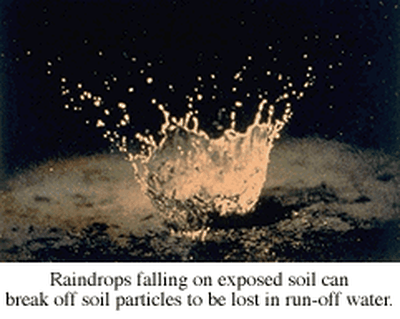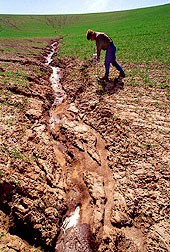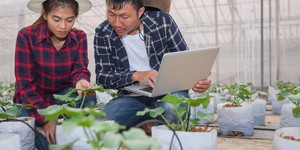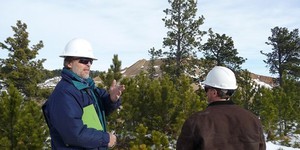Abstract
When you think of environmental challenges facing the world, the first things that come to mind might be global warming, or loss of biodiversity, since these are often in the newspapers. A serious problem that you may not have heard about is soil erosion. Why is soil so important? What is the danger of erosion? How can we measure soil erosion? What can be done to prevent it? Check out this project and you can start finding answers.Summary
Andrew Olson, Ph.D., Science Buddies
Sources
- Agricultural Research Service. (2011, February 14). Agricultural Ideas for Science Fair Projects United States Department of Agriculture. Retrieved May 30, 2014.
- Global Learning and Observations to Benefit the Environment (GLOBE). (2005). GLOBE Soil Science Protocols: Introduction. Retrieved May 30, 2014.

Objective
The goal of this project is to estimate rates of soil erosion due to rainfall at different sites using homemade sampling containers.
Introduction
"Soils are one of Earth's essential natural resources, yet they are often taken for granted. Most people do not realize that soils are a living, breathing world supporting nearly all terrestrial life." (GLOBE, 2005)
We depend on soil for food production from crops, but our dependence on the soil goes much deeper than that. Soil is such a vital part of every ecosystem on Earth that it is often called "the great integrator" (GLOBE, 2005). Here are some examples that help to explain the nickname: "Soils hold nutrients and water for plants and animals. They filter and clean water that passes through them. They can change the chemistry of water and the amount that recharges the groundwater or returns to the atmosphere to form rain. The foods we eat and most of the materials we use for paper, buildings, and clothing are dependent on soils. Soils play an important role in the amount and types of gases in the atmosphere. They store and transfer heat, affect the temperature of the atmosphere, and control the activities of plants and other organisms living in the soil." (GLOBE, 2005)
Yet arable soil covers only a small fraction of the Earth's surface—about 10% (Levine, 2001, see Bibliography for an interesting web-based demonstration of this fact). Soil formation is a grindingly slow process. To produce one inch of soil can take 500 years (NRCS, 2001, see Bibliography). When rates of soil loss due to erosion exceed the slow rate of soil formation, this vital natural resource can be lost for good.
 Image Credit: Cullen Gunn / unknown
Image Credit: Cullen Gunn / unknown
In this project you will investigate how rainfall affects soils on slopes. You will make sampling containers to catch rainwater in several locations, and you will measure the amount of soil carried into the containers by the rainwater. Choose several different sites for testing. Variables you may want to investigate could include, for example, degree of slope, amount of plant cover, or type of soil. Choose a sufficient number of sites so that you can compare the variable of interest as the sole change between sites. For example, if you wanted to investigate degree of slope, you should select at least three sites with similar soil types and plant cover but different slopes. If you want to investigate the effect of plant cover, select at least three sites with similar slope and soil type, but different amounts (or types) of cover. If possible, use multiple sampling containers at your sites, so that you can average the results.
Terms and Concepts
To do this project, you should do research that enables you to understand the following terms and concepts:
- Erosion terms:
- Sheet-wash
- Rilling
- Surface gullying
- Tunneling
- Bank scouring
- Wind erosion
- Slope
- Soil formation
- Soil types
Questions
- What are the main causes of soil erosion?
- How does plant cover affect soil erosion?
Bibliography
- NRCS. (n.d.). Helping People Understand Soils: Ten Key Messages. National Resources Conservation Service, USDA. Retrieved March 14, 2006.
- Here are some websites with information on soil erosion:
- Favis-Mortlock, D. (2005, June). The Soil Erosion Site. Retrieved March 14, 2006.
- Anthoni, J.F. (2000). Soil: Erosion and Conservation. Seafriends. Retrieved March 14, 2006.
- This webpage has information on measuring slope with simple homemade tools:
CETS. (2002). Making and Using Measurement Tools - Slope. Communication and Educational Technology Services, University of Minnesota Extension Service. Retrieved May 30, 2014.
Materials and Equipment
To do this experiment you will need the following materials and equipment:
- About a dozen empty soda bottles or milk jugs
- Utility knife (use with care!)
- Shovel
- Open spaces with a slope and permission to dig test sites
- Oven and baking sheets or pie tins for drying soil samples
- Scale for weighing dried soil samples, such as the digital pocket scale from Amazon.com
You will need a way to measure the slope of your test sites. The final Bibliography entry (CETS, 2002) describes one method for measuring slope with homemade measuring tools. Here are the materials you will need:
- Two wooden dowels or stakes
- String
- Permanent marker or tape
- Line level
- Ruler
Disclaimer: Science Buddies participates in affiliate programs with Home Science Tools, Amazon.com, Carolina Biological, and Jameco Electronics. Proceeds from the affiliate programs help support Science Buddies, a 501(c)(3) public charity, and keep our resources free for everyone. Our top priority is student learning. If you have any comments (positive or negative) related to purchases you've made for science projects from recommendations on our site, please let us know. Write to us at scibuddy@sciencebuddies.org.
Experimental Procedure
- Find patches of different types of soil that are on slight slopes or hillsides.
- Alternatively, you could look for patches of the same soil type with different amounts of plant cover, for example, bare soil and a grassy area.
- Alternatively, you could compare different degrees of slope with the same soil type and plant cover.
- Choose a sufficient number of sites so that you can compare the variable of interest as the sole change between sites. For example, if you wanted to investigate degree of slope, you should select at least three sites with similar soil types and plant cover but different slopes. If you want to investigate the effect of plant cover, select at least three sites with similar slope and soil type, but different amounts (or types) of cover.
- For each test site, make 3 sampling containers.
- Cut the tops off plastic bottles such as soda bottles or milk jugs. Use the utility knife safely: keep your fingers away from the path of the blade.
- Use the same size bottle for all sites.
- Bury each container so the lip is even with or slightly below the soil surface.
- Weigh the soil that collects in the containers after each rain. Dry the soil in an oven before you weigh it; you don't want to weigh the water, just the soil.
- Keep records in your lab notebook.
- You'll want to have a description of each test site, including information about the slope (see Bibliography for a good method for measuring slope), soil type and plant cover.
- For a method for determining soil type, see the Science Buddies project Get Down and Dirty: How Does Soil Change with Depth? You can use step 10 in the Experimental Procedure from that project to determine the soil texture, using a sample of soil from each site.
- You'll want to note the location of each of your sampling containers (use a sketch or take photos).
- Make notes about the time and date of each sample collection, the amount of rainfall and the amount of soil (dry weight) collected.
- Average the results from the sampling containers at each test site and make graphs to compare the average amount of soil collected at the different sites. Which sites had the most erosion? Which sites had the least?
Ask an Expert
Global Connections
The United Nations Sustainable Development Goals (UNSDGs) are a blueprint to achieve a better and more sustainable future for all.
Variations
- If you can't find an open space for doing this experiment "in the field," then here is a way to adapt the experiment to your backyard. Buy or make one or more long planter boxes. (If you use a single box, you'll do your experiments one after the other. If you have multiple boxes, you can do the experiments in parallel.) Cut a square of sod to from your lawn (get permission first) so that it fits in one end of the planter box. In the other planter box, put a similar amount of bare topsoil. Tilt the planter box up to simulate the slope of a hillside (sod/soil end should be uphill). Water with a watering can to simulate rainfall. Collect the water from the low end of the planter box. Dry out the soil that collects in the bottom end of the planter box (as described in Experimental Procedure, step 3), and weigh the amount of dry soil. Which condition showed more erosion? There are lots of variables you could test with this setup: different soil types, different plant cover, different slopes, different rates of "rainfall" from the watering can, different watering heights: how does this affect impact and splash? Does your planter box catch all of the splashed water?. How could you modify the setup if it doesn't?
- For an ambitious follow-on project, you could start by measuring erosion on a bare, sloped area, then plant it and do a follow-up study once the new vegetation has taken hold. Did the plants reduce soil erosion?
Careers
If you like this project, you might enjoy exploring these related careers:











